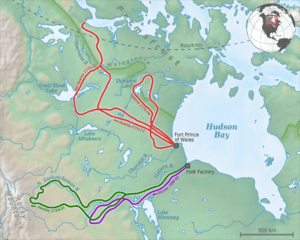Anthony Henday
Anthony Henday (fl. 1750–1762) was one of the first Europeans to explore the interior of the Canadian northwest.
Anthony Henday | |
|---|---|
| Born | Isle of Wight, England |
| Occupation | Explorer |
| Years active | 1750–62 |
Early life
Henday was from the Isle of Wight, England. He may have been baptised in Shorwell on 24 December 1725.[1]
Hudson's Bay Company
A convicted smuggler,[2] Henday joined the Hudson's Bay Company (HBC) in 1750 as a net-maker and labourer.
From the 1600s to the late 1800s the HBC had the exclusive fur trade for the land within what was considered Hudson Bay's watershed. This region was known as Rupert's Land. For the furs that HBC was after they wanted to trade commodities such as tobacco, kettles, axes, mirrors, beads, and alcohol.
Because of the HBC's concern with La Vérendrye and the other western commanders who were funnelling fur trade from the northwest to their forts, Eventually, James Isham, chief at York Fort, suggested someone go to western Rupert's Land to encourage trade with the region's First Nations tribes.[3] The HBC authorized and funded Henday to lead explorations into the interior of Rupert's Land, using York Factory as his base. On June 26, 1754, he set out with a group of Cree Indians on foot to travel from York Factory to present-day Red Deer, Alberta. It is documented they passed the French Fort Paskoya where he may have met La Corne, the western commander.

On September 10, 1754 Henday and his party camped approximately eighteen miles north-east of where Chauvin is located today, quite possibly at Sherlock Lake. The following day, Wednesday, September 11, 1754 he crossed over from Saskatchewan into present-day Alberta. However, he did not arrive at Waskesew River until Friday, October 11, 1754. Waskesew is a mistranslation of the Cree word for elk. The Cree in the Red Deer area call the central Alberta city Waskesew Ceepee. Instead of Red Deer the city might well be called Elk River.[4] In October 1754 he and his group came to what is now Alberta with a mission to meet the Blackfoot and perhaps trade with them.
Henday may not have been aware that the Blackfoot and the Cree were arch enemies. There is some indication in Henday's journal entries that the Cree were becoming wary of the other tribes Henday and his Cree companions were encountering. While the group was travelling in what Henday refers to the "Muscuty plains" they come across a man named "Attickasish with 2 Archithinue Natives (Blackfeet)". He says these Indians had never been in contact with any Europeans and his Cree travelling companions were afraid of them. Then on Monday, October 14, 1754 Archithinue Natives on horse back approached them and ask them if they were friend or foe. That evening Henday and his guide met and smoked with the Leader of the Archithinue Natives. Henday offered to have some of the Archithinues go back with them back to York Factory. The Archithinue Leader did not readily answer Henday and the Leader went on to say that they (Archithinue) could not paddle and the it (York Factory) was too far. The Leader of the Archithinue, probably, knew that his men would be travelling uninvited in Cree territory and would risk being killed off by the Cree and other enemy tribes.[5] After receiving an indefinite answer from the Blackfoot (which Henday took as a "no"), Henday returned to York Factory with news he had explored the area and met with the Blackfoot. Since the answer had been unsure, there were no more expeditions to what would eventually be Alberta until Peter Fidler in 1792.
As Henday travelled inland to the Blackfoot country and back to York Factory, he talked about the Indians having some problems with alcohol. He mentions on one day that his whole company was unable to travel because everyone was drinking. On Friday, 30 May 1755 Henday remarks in his journal that he is unable to continue their travels back to York Factory because "the Indians drank too much" but they were using their best furs to trade with the French for the alcohol.[6][7]
This trip, and later ones, took Henday across much of the prairies of what are now Saskatchewan and Alberta. Although his journal cannot always be put in a modern context, it is evident he brought much trade to York Factory. Records show some of the trade also went to the French at Fort Saint-Louis (Fort de la Corne) and Fort Paskoya which were on the route to Hudson Bay. He left the service of the HBC in 1762 largely because his efforts for the company, at least in his estimation, had not been properly recognized.
Legacy
Anthony Henday Drive, a large ring road in Edmonton, is named in his honour, as is Henday Hall, one of the residence towers in the main student residence complex at the University of Alberta in that city.
See also
References
- Stephen, Scott P. (July 1997). A Puzzle Revisited: Historiography and Documentary Problems in the Journals of Anthony Henday (MA). University of Winnipeg/University of Manitoba.
- "Calgary & Southern Alberta". Archived from the original on 2012-10-07. Retrieved 2017-08-24.
- Wilson, Clifford (1974). "Henday, Anthony". In Halpenny, Francess G (ed.). Dictionary of Canadian Biography. III (1741–1770) (online ed.). University of Toronto Press.
- Burpee, Lawrence, ed. (1908). York Factory to the Blackfoot Country. The Journal of Anthony Henday 1754-55. Edmonton: University of Alberta Press. pp. 332, 336.CS1 maint: ref=harv (link), Claude Saddleback is a fluent Cree -speaking First Nations member.
- Burpee (1908), pp. 331, 337 & 338
- Davis, Richard C., ed. (1988). Rupert's Land: A Cultural Tapestry. Wilfrid Laurier University Press. pp. Introduction, 60. ISBN 978-0-88920-839-1.
- Henday, Anthony; Burpee, Lawrence J. (1973). A Fur Trader's Journey 1754-55: York Factory to the Blackfoot Country. Toronto: Canadiana House. p. 46.